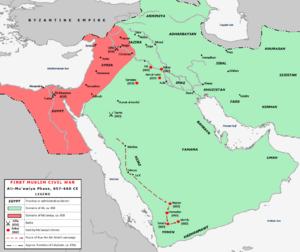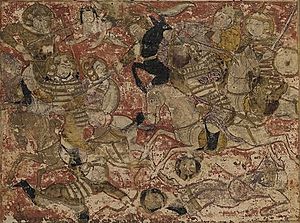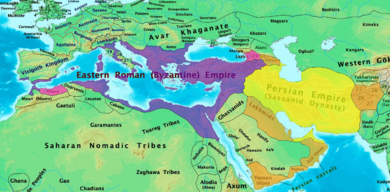First Fitna facts for kids
The First Fitna was the first big civil war in the early Islamic community. It happened between 656 and 661 CE. This war led to the end of the Rashidun Caliphate and the start of the Umayyad Caliphate. It was a tough time with three main battles between the fourth leader, or caliph, Ali, and groups who rebelled against him.
Quick facts for kids First Fitna |
||||||||
|---|---|---|---|---|---|---|---|---|
| Part of the Fitnas | ||||||||
 Region under the control of Caliph Ali Region under the control of Mu'awiya |
||||||||
|
||||||||
| Belligerents | ||||||||
| Commanders and leaders | ||||||||
|
Ali X |
Aisha Talha † Zubayr ibn al-Awwam X Mu'awiya I 'Amr ibn al-'As (WIA) Marwan I (POW) |
Abd Allah ibn Wahb al-Rasibi † | ||||||
| Casualties and losses | ||||||||
Total: 25,407–25,513+
|
Total: 47,500+
|
2,400 | ||||||
The problems started after the second caliph, Umar, was killed in 644 CE. Before he died, a special group chose Uthman to be the next caliph. Later, some people accused Uthman of favoring his family too much. He was killed by rebels in 656 CE. After Uthman's death, Ali was chosen as the fourth caliph.
However, some important figures like Aisha (Muhammad's widow), Talha, and Zubayr did not agree with Ali becoming caliph. They revolted against him. These two sides fought the Battle of the Camel in December 656 CE, and Ali won.
After this, Mu'awiya, who was the governor of Syria, declared war on Ali. He said he wanted to get revenge for Uthman's death. Ali and Mu'awiya's forces fought the Battle of Siffin in July 657 CE. This battle ended in a tie, and they decided to try to settle things peacefully through a process called arbitration.
This arbitration made a group called the Kharijites very angry. They believed that only God could judge, not people. They said Ali, Mu'awiya, and their followers were not true Muslims. The Kharijites started attacking innocent people. Ali's forces then fought and defeated them in the Battle of Nahrawan. Soon after, Mu'awiya also took control of Egypt with help from Amr ibn al-As.
In 661 CE, Ali was killed by a Kharijite named Abd al-Rahman ibn Muljam. After Ali's death, his son Hasan became caliph. But Mu'awiya quickly attacked him. Hasan, facing many problems, made a peace treaty with Mu'awiya. In this treaty, Hasan gave up being caliph to Mu'awiya. Mu'awiya then started the Umayyad Caliphate and became its first caliph.
Contents
How the Conflict Started
After the Prophet Muhammad died in 632 CE, Abu Bakr became the first leader of the Muslim community. He sent armies to fight against the powerful Byzantine Empire and Sasanian Persia. These battles were very successful and brought a lot of wealth and land to the Muslims.
When Umar became the second caliph (634–644 CE), he continued these conquests. The Sasanian Empire almost completely fell, and the Byzantine Empire lost much of its land. The new lands and money were shared among the Muslim soldiers who settled in places like Iraq. Umar also let regional governors rule with a lot of freedom.
Uthman became caliph after Umar was killed in 644 CE. Uthman started to centralize power and relied heavily on his own family, the Umayyads. This made many other important Muslim leaders unhappy because they felt left out. He appointed his relatives to lead many provinces.
The conquests slowed down during Uthman's later years. This meant less new wealth coming in, which caused money problems. Also, many Arab tribes moved to the new lands, which meant the older settlers got less money from the land. Uthman also took control of lands in Iraq that used to belong to the Persian rulers. He demanded that money from the provinces be sent to the capital, Medina. This made many people in Iraq and Egypt very angry.
Important leaders in Medina, like Talha, Zubayr, Amr ibn al-As, and Aisha, encouraged the opposition. People from Egypt and Iraq marched to Medina and killed Uthman in June 656 CE. After this, Ali, who was Muhammad's cousin and son-in-law, was recognized as the new caliph.
The Battle of the Camel

Aisha, Talha, and Zubayr did not accept Ali as caliph. They gathered in Mecca and demanded justice for Uthman's death. They wanted a new caliph to be chosen. These rebels formed an army and took control of Basra, causing many casualties to Ali's men. They wanted to make their position stronger.
Ali sent his son Hasan to gather troops in Kufa. Once Ali arrived in Kufa, their combined army marched to Basra. The two armies met outside Basra. After three days of talks that failed, the battle began on December 8, 656 CE.
Zubayr left the battle without fighting and was later killed. Talha was also killed by Marwan ibn al-Hakam. With Talha and Zubayr dead, Ali was clearly winning. The fighting continued until Ali's soldiers managed to kill Aisha's camel. Her forces had gathered around this camel, which is how the battle got its name. Ali then sent Aisha back to Medina safely. He also forgave the prisoners and even high-ranking rebels like Marwan, who later joined Mu'awiya.
The Battle of Siffin
Soon after becoming caliph, Ali removed most governors he thought were corrupt. This included Mu'awiya, who was Uthman's cousin. Mu'awiya refused to step down. He told Ali he would recognize him as caliph if he could be governor of Syria and Egypt for life. Ali said no to this offer.
Mu'awiya then declared war on Ali, saying he wanted revenge for Uthman's death. He wanted to remove Ali and have a Syrian council choose the next caliph, hoping it would be himself. Ali told Mu'awiya to bring any proof against him to Ali's court. He also challenged Mu'awiya to a one-on-one duel to avoid more bloodshed, but Mu'awiya declined.
The two armies met at Siffin, near the Euphrates River, in 657 CE. They talked for weeks, but couldn't agree. The battle started on July 26 and lasted for several days. When Ali's army was about to win, Mu'awiya's soldiers raised copies of the Quran on their spears. They shouted, "Let the book of God be the judge between us!"
Ali was suspicious, but his soldiers stopped fighting. Because his army strongly wanted peace, Ali agreed to try to settle things through arbitration.
Arbitration
Most of Ali's army wanted Abu Musa al-Ashari to represent them. Ali thought Abu Musa was not good at politics, but he still appointed him. On August 2, 657 CE, Abu Musa represented Ali's army, and Mu'awiya's general, Amr ibn al-As, represented his side. They promised to follow the Quran and the teachings of Muhammad (Sunnah) to stop the war.
The two arbitrators met twice. First, they met at Dumat al-Jandal. There, they decided that Uthman had been killed unfairly and that Mu'awiya had the right to seek revenge. This decision helped Mu'awiya and weakened Ali's position.
Their second meeting at Udhruh ended badly. Amr broke his agreement with Abu Musa. Ali's supporters were furious with Abu Musa, who then fled. Amr, however, was welcomed back by Mu'awiya as a hero. After the arbitration ended in 659 CE, Syrians swore loyalty to Mu'awiya as the next caliph. Ali said the arbitrators' actions went against the Quran and began planning a new attack on Syria.
The Battle of Nahrawan
After the Battle of Siffin, a group of Ali's followers left him. They were angry that he agreed to arbitration, saying it went against the Quran. This group became known as the Kharijites, which means "those who went out" or "rebelled."

The Kharijites chose Abd Allah ibn Wahb al-Rasibi as their leader. They said Ali, his followers, and the Syrians were not true Muslims. They believed it was right to kill such "infidels." The Kharijites started questioning people about their views on Uthman and Ali. They killed those who disagreed with them.
When Ali heard about the Kharijites' violence, he moved his army to Nahrawan. After trying to make peace several times, Ali offered them a pardon. His army was much larger than the Kharijites'. The remaining Kharijites, about 2,800, attacked and were defeated. Ali pardoned the injured, who were about 400.
In January 661 CE, Ali was praying at the Mosque of Kufa when he was killed by a Kharijite named Abd al-Rahman ibn Muljam.
Peace Treaty with Hasan
After Ali was killed in January 661 CE, his oldest son, Hasan, was chosen as caliph in Kufa. Mu'awiya quickly marched towards Kufa with a large army. Many of Hasan's soldiers left him because Mu'awiya had promised money and rewards to their commanders and tribal leaders. Hasan was also wounded in an attempt to kill him.
By the time Hasan agreed to a peace treaty with Mu'awiya, his power only covered the area around Kufa. In this treaty, Hasan gave up the caliphate to Mu'awiya. The treaty also said that everyone would be forgiven, and that the caliphate would return to Hasan after Mu'awiya died. Mu'awiya was crowned as caliph in Jerusalem in 661 CE.
Hasan died in 670 CE, when he was 46 years old, before Mu'awiya. Many believe he was poisoned because Mu'awiya wanted him dead.
Images for kids
-
Byzantine Empire and Sasanian Empire, 600 CE
-
The Nahrawan Canal ran parallel to the east bank of the Tigris.




